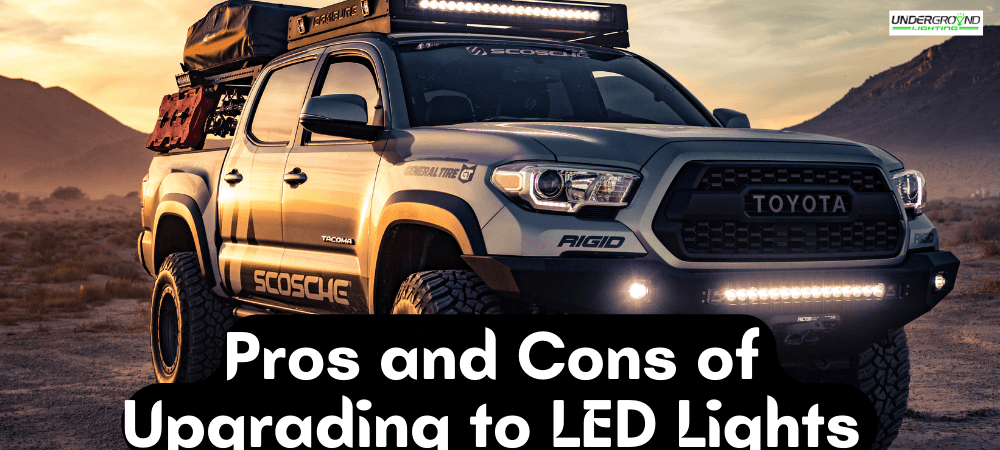LED lights are one of the brightest sets of lighting you can have, and owning them can come with many advantages. They are capable of replacing any light bulb and can give you a better lighting scheme. Some have even discovered that they can get a better atmosphere when they use LED lights.
Still, as seamless as upgrading to LED lights is, some will often run into certain issues in most cases. This article highlights some of the benefits of upgrading to LED lights and how you decide if upgrading is worth it.
Also Read, WHAT MAKES A GOOD LED HEADLIGHT BULB - FULLY EXPLAINED
What are LED Lights?
LED stands for the light-emitting diode. It is a semiconductor device that produces light when an electric current passes through it. The diode has two semiconductors that have electrons that combine to produce light. The wavelength of light depends on the bandgap of the semiconductor material.
LED lights have a distinct difference from incandescent and fluorescent lights. Other light sources spread light and heat in all directions, but LED lights are directional light sources, producing light in one direction. In addition, they are more efficient, versatile, and last longer.
Also Read, CAN YOU REPLACE HALOGEN HEADLIGHTS WITH LED?
Things To Consider While Upgrading To LED Light
Given the challenges of upgrading to LED light, there are a few points you need to consider before deciding on upgrading. Here are some of them:
- The Lumen output. Compare LED lights with traditional lighting to ensure you get a better output than before.
- LED lights tend to give off different color hues. Check the color temperature to note how warm or cold the light temperature will be.
- The light distribution. Endeavor to choose the closest beam angle possible, to avoid drastically altering the look of your space.
- Ensure the product manufacturer has a good track record of getting the best benefits from your LED bulbs.
- Consider the Warranty of each bulb. Most LED bulbs come with time frame assurance and exploit them to save money in the long run.
Also Read, HEADLIGHTS COMPARISON: CHOOSE THE BEST & BRIGHTEST LED HEADLIGHTS BULBS
What are the Pros of LED Lights?
LED lighting is not just one of the latest developments in the lighting industry, they also have several advantages, so it only makes sense that you upgrade to them. Here are some pros of using LED lights:
LED Lights Are More Energy Efficient
Incandescent lights not only produce light in multiple directions but also produce much heat, which causes them to waste energy. LED lights produce less heat and thus conserve more energy. It is estimated that replacing all light in your facilities can lead to a 60-70% improvement in energy efficiency. In some cases, people have even experienced a 90% improvement.
They Have a Longer Lifespan
LED lights have a far superior lifespan than incandescent and fluorescent bulbs. Incandescent bulbs last about a thousand hours, while LED lights can last about fifty thousand hours depending on how you use them; that is about forty times the lifespan of incandescent bulbs. Some LED bulbs can be used for twelve years if used properly.
They Can Operate In Cold Weather
Traditional lighting sources don't often go well with cold weather, and it isn't unusual for lights from fluorescent bulbs to diminish or consume higher voltage when the temperature drops. Contrarily, LED lights perform better in cold weather.
Good For the Environment
There is a lot of pressure on companies to become eco-friendly, and nothing can help them more than upgrading to LED lights. The environmental benefits of LEDs extend down to their manufacturing process.
Some traditional lighting uses mercury internally as part of its construction; this can lead to mercury poisoning if not handled specially. LED lighting is produced in an environmentally sound manner, and they also save energy which also helps the environment.
Design Flexibility
Another good thing about LED lights is their ability to craft designs easily. The components of traditional lighting tend to lead to a form of design rigidity; this is not the case with LED lights. You can use them in strings, as a bunch, or in small or large sizes; they give you multiple design options.
Also Read, BEST LED LIGHT ACCESSORIES FOR CARS
What are the Cons of LED Lights?
No doubt LED lights have profound benefits, but there are some disadvantages you must overcome while upgrading to them. Here are just a few of them:
Expensive Upfront Price
LED lights are super energy efficient and last longer; this can save you money in energy consumption and LED purchases, but they will cost you initially. LED lightings are more expensive than traditional lighting, and some often find that an initial upgrade to LED lighting will greatly strain their budget despite the future advantages.
Additional Blue Lighting
LED bulbs emit light through the interaction of electrons on semiconductors; this unique structure causes them to release more blue light than incandescent and fluorescent bulbs. Blue light has a lot of negative side effects, including disruption to the circadian rhythm, which negatively affects the ability to fall asleep. If LEDs are used in private homes, it could affect the homeowners' sleep quality.
Change of Lighting Fixtures
Sometimes upgrading to LED lights may require changing existing light fixtures because some LED bulbs may not be compatible with the existing fixtures. Buying new fixtures may also add to the cost of upgrading to LED lighting.
Conclusion
Lighting technology is always evolving, and LED lights are some of the most recent developments. They offer many unique benefits, including increased energy efficiency, longevity, and more directional brightness—however, their challenges include high upfront costs and increased blue light emission. Carefully make good considerations before choosing to upgrade your lighting system.

